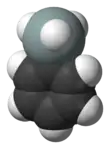Phenylsilane
Phenylsilane, also known as silylbenzene, a colorless liquid, is one of the simplest organosilanes with the formula C6H5SiH3. It is structurally related to toluene, with a silyl group replacing the methyl group. Both of these compounds have similar densities and boiling points due to these similarities. Phenylsilane is soluble in organic solvents.
| |||
| Names | |||
|---|---|---|---|
| Other names
Silylbenzene | |||
| Identifiers | |||
3D model (JSmol) |
|||
| ChemSpider | |||
| ECHA InfoCard | 100.010.703 | ||
PubChem CID |
|||
| UNII | |||
CompTox Dashboard (EPA) |
|||
| |||
| |||
| Properties | |||
| C6H8Si | |||
| Molar mass | 108.215 g·mol−1 | ||
| Appearance | Colorless liquid | ||
| Density | 0.878 g/cm3 | ||
| Boiling point | 119 to 121 °C (246 to 250 °F; 392 to 394 K) | ||
| Hydrolyzes | |||
| Hazards | |||
| Safety data sheet | MSDS | ||
| R-phrases (outdated) | R11-R14/15-R20/22-R36/37/38 | ||
| S-phrases (outdated) | S16-S43 | ||
Except where otherwise noted, data are given for materials in their standard state (at 25 °C [77 °F], 100 kPa). | |||
| Infobox references | |||
Synthesis and reactions
Phenylsilane is produced in two steps from Si(OEt)4. In the first step, phenylmagnesium bromide is added to form Ph-Si(OEt)3 via a Grignard reaction. Reduction of the resulting Ph-Si(OEt)3 product with LiAlH4 affords phenylsilane.[1]
- Ph-MgBr + Si(OEt)4 → Ph-Si(OEt)3 + MgBr(OEt)
- 4 Ph-Si(OEt)3 + 3 LiAlH4 → 4 Ph-SiH3 + 3 LiAl(OEt)4
Uses
Phenylsilane can be used to reduce tertiary phosphine oxides to the corresponding tertiary phosphine.
- P(CH3)3O + PhSiH3 --> P(CH3)3 + PhSiH2OH
The use of phenylsilane proceeds with retention of configuration at the phosphine. For example, cyclic chiral tertiary phosphine oxides can be reduced to cyclic tertiary phosphines.[2]
Phenylsilane can also be combined with cesium fluoride. In aprotic solvents, it becomes a nonnucleophilic hydride donor. Specifically, phenylsilane-caesium fluoride has been shown to reduce 4-oxazolium salts to 4-oxazolines. This reduction gives yields of 95%.[3]
References
- Minge, O.; Mitzel, N. W.; and Schmidbaur, H. Synthetic Pathways to Hydrogen-Rich Polysilylated Arenes from Trialkoxysilanes and Other Precursors. Organometallics 2002, 21, 680-684. doi:10.1021/om0108595
- Weber, W. P. Silicon Reagents for Organic Synthesis. Springer-Verlag: Berlin, 1983. ISBN 0-387-11675-3.
- Fleck, T. J. Encyclopedia of Reagents for Organic Synthesis doi:10.1002/047084289X.rp101

